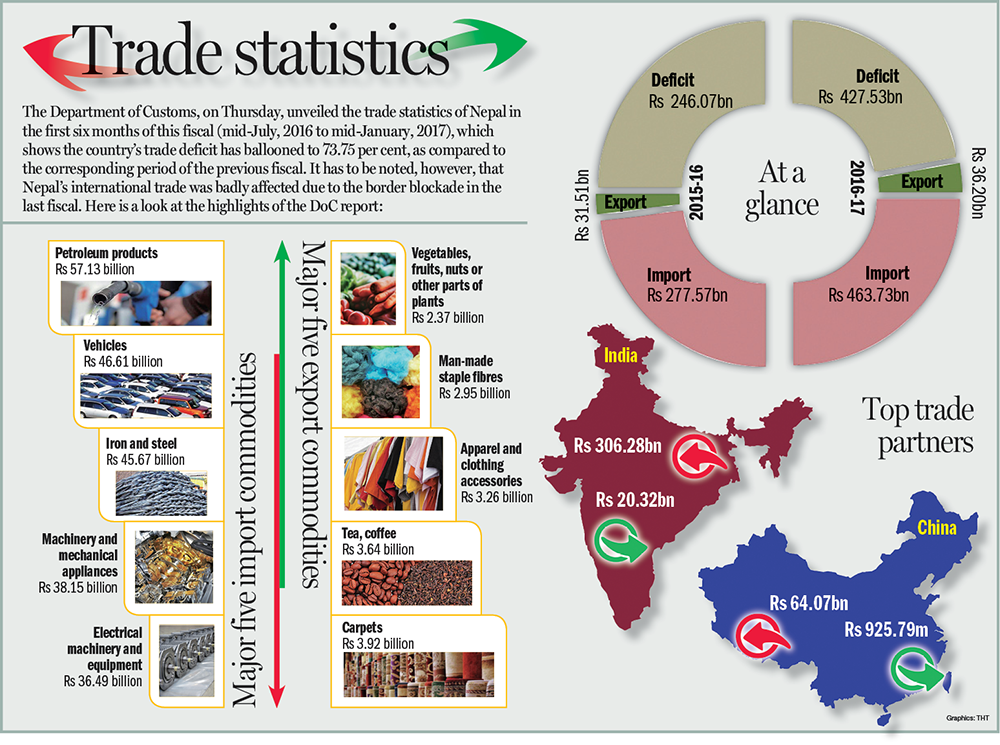Nepal could miss 2030 Agenda target on trade
Kathmandu, March 29
At a time when the government has been pushing to boost the production base of Nepal and curb the ballooning trade deficit, a report has highlighted the chances of some least developed countries, including Nepal, in failing to meet the target set in the 2030 Agenda for Sustainable Development to double the world exports share of least developed countries by 2020.
“Based on the historical growth rates, the target seems attainable for such countries as Bangladesh, Cambodia … (but) this target will be ambitious for other least developed countries, like Nepal, Afghanistan, Bhutan …” says a report titled ‘Asia-Pacific Sustainable Development Goals Outlook’ unveiled by the Asian Development Bank today.
The high growth rates of exports between 2000 and 2010 in least developed countries and developing countries were mainly enabled by high commodity prices and rising demand from emerging markets, especially China, as per the report. Since both drivers have since weakened, ‘global and regional economic headwinds will impact, to a large extent, the feasibility of achieving these targets’.
The report has pointed to the substantial uncertainty due to the global economic conditions, lack of progress in multilateral trade liberalisation, potential weakening of the global trade regime under the World Trade Organisation due to parallel trade liberalisation initiatives and pressures for use of more protectionist measures.
“Least developed countries remain particularly vulnerable to external shocks, and their production structure constrains them from fully benefiting from trade,” the report says. “The potential contribution of agriculture as an instrumental sector for poverty reduction is limited by both tariff and non-tariff measures affecting agricultural trade and production.”
Greater attention need to be given to the recent developments in international trade policies, in order to maintain and improve the preferential market access of least developed countries, as per the ADB report.
Developing countries of Asia and the Pacific have increased their share in world merchandise exports from 24.4 per cent in 2005 to 33.2 per cent in 2015, and have recorded an increase in the share of their services exports, from 14.4 per cent to 23.6 per cent over the same period.
In stark contrast, least developed countries within the region accounted for only 0.2 per cent of global exports (goods and services combined) in 2015. “There has been a substantial slowdown in the growth rate of this share since 2010, compared with the 2005-10 period,” the report says.
The report has also stressed how the trade-related indicators within the SDG framework do not fully capture many significant emerging issues, such as services trade restrictions, non-tariff measures, quality of exports or e-commerce.
The number of preferential trade agreements, which tend to exclude least developing countries, is on the rise, the report says, adding, “This may lead to erosion in the relative preference margin obtained by least developed country exports and can emerge as an important impediment in the expansion of exports from least developed countries.”
Moreover, the increasing use of non-tariff measures presents a big challenge to market access for exports from developing countries, including least developed countries.
As digital trade, or e-commerce, is emerging as an important enabler of trade, the report has recommended countries to evaluate their readiness and capability to develop digital trade and monitor its impact on sustainable development.
Lastly, the report has said, plurilateral trade negotiations are expected to gain more prominence, and their impact on the multilateral global trading system needs to be closely watched.






